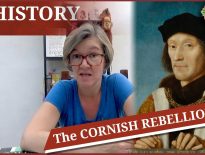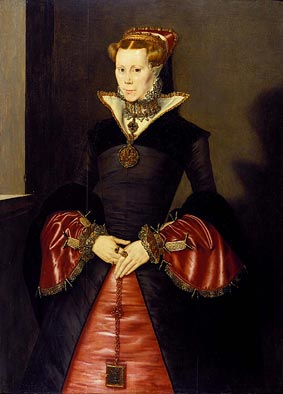On this day in Tudor history, 16th June 1487, the final battle of the Wars of the Roses took place when the forces of Henry VII met the Yorkist forces of Lord Lovell and John de la Pole, Earl of Lincoln, who had recently crowned Lambert Simnel as King Edward VI.
Who won that day? What happened? And what happened to the boy, Lambert Simnel?
Also on this day in history:
- 1514 - Tudor scholar, humanist and administrator, Sir John Cheke, was born on 16th June 1514 in Cambridge.
- 1614 – Death of Henry Howard, Earl of Northampton, author, courtier and administrator, at his house in Charing Cross. He died of gangrene after an operation on a tumour on his thigh. Northampton is known for his learning and intelligence, but also for his alleged involvement in the Overbury scandal, the plot that led to the poisoning of Thomas Overbury in the Tower of London. Although it is not known whether Northampton was definitely involved, it was something that affected his posthumous reputation. His niece Frances Howard, Countess of Somerset, and her husband were tried after Northampton's death, and the lawyer for the prosecution claimed that Northampton was involved. Of course, he was not there to defend himself.



Lord Francis Lovell disappeared afterwards and was never caught or seen again but the theory is that he was badly wounded and made it home to Minster Lovell and then he was cared for by his mother and eventually died. Nobody knew what happened to his body but in the eighteenth century workers knocking down a wall found a hidden submerged room and inside a man in a chair at a desk. It was assumed and is still said to be the skeleton of Lord Francis Lovell who died of his wounds back in 1487.
Although the official version of the story is that John de la Pole was using Lambert Simnel to be a false Edward Earl of Warwick other sources named the boy found on the battlefield as John and others indicated a plot to free the real Warwick. More recent studies have revealed evidence that some sources also believed he was Edward V. Whoever he was, however, John de la Pole obviously thought he was important enough or he could pass him off as someone important enough to rule as he himself of course had a claim to the crown. The boy was taken to Ireland, carried through the streets of Dublin and actually crowned in Dublin Cathedral. Normally in the one source his numerical identification was mentioned, the York Books, it is read as Edward Vi, which of course is what Warwick would be. Notice though that the i appears to be squeezed in as if added later. The plot certainly thickened. Whoever he was meant to be the boy was very lucky that Henry saw him as a dupe and took him first of all into his household as a spit turnover and then later he served as a falconer. The Irish Lords who came to meet and dine with Henry Vii years later were presented with Lambert apparently and said he wasn’t the same boy they had crowned and greeted years earlier. Just what really happened is something else to debate. However, the victory of East Stoke at which John de la Pole, Earl of Lincoln was killed ended the immediate threat to Henry and stabilized his new crown. He had an heir in Prince Arthur. Now it was time to crown his Queen, Elizabeth of York.
However, Henry would face a much more dangerous threat in the shape of one Perkin Warbeck or Osbeck who to many in England and abroad was Richard of England, the Duke of York, the younger son of Edward iv and one of the lost Princes in the Tower. This threat ran from 1493 to 1499 and seriously it was really one which had Henry seriously worried.
Was John de la Pole related to the family Margaret Pole married in to? Just wondering. Thanks for explaining. This is the part of Tudor history I’m least familiar with. And I did think it was over at the Battle of Bosworth. Thanks again ! Michelle t
John de la Pole, Earl of Lincoln was the son of Princess Elizabeth Plantagenet, Duchess of Suffolk and her husband John de la Pole, 2nd Duke of Suffolk. Elizabeth, his mother was the sister of King Edward iv and King Richard iii, the third daughter of Richard, Duke of York and Cecily Neville, daughter of Warwick the Kingmaker.
Margaret Pole was Margaret Plantagenet, daughter of George, Duke of Clarence, the brother of the above Kings and Elizabeth, Duchess of Suffolk. Therefore, yes, they were related as cousins. Margaret was married off to Sir Richard Pole in order to remind her that her family had lost the right to the Succession by Henry Vii but was made Countess of Salisbury in her own right to acknowledge her royal status by Henry Viii. She was widowed in 1505 with five children and she became close to both Queen Katherine of Aragon and the King and Governess to Princess Mary. Her father, George, Duke of Clarence was the famous Clarence of the Shakespeare play and he really was drowned in a large wine press. King Edward condemned him in 1477 for his numerous betrayals and he was executed in private on 18th February 1478. Richard had nothing to do with it. An Act of Parliament barred his children from the Succession and of course Henry Vii made certain of that. Her brother Edward, Earl of Warwick was held in the Tower by him from the age of eight and was held there until his execution by Henry in 1499, after the long affair with Perkin Warbeck. Margaret and her sons prospered for several years at the Tudor Court until after the divorce and the trouble with her son, Reginald Pole. Her family only became a threat after Henry Viii failed to get hold of Cardinal Pole and their association with the so called Exeter plot in 1539_probably invented by Cromwell, that the entire family were rounded up and most of them, including Margaret herself, executed or imprisoned. It was a bad business which saw the deaths of Henry, her eldest son, her son in law, the demise of her son Geoffrey into near insanity, the mysterious disappearance of her grandson, a young child in the Tower, who was possibly poisoned and the brutal execution of the elderly Margaret Pole in May 1541.
But, yes, Margaret Pole and John de la Pole, Earl of Lincoln were in fact cousins as their parents were both siblings and children of Richard, Duke of York.